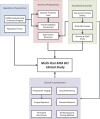Collaborative approach in the development of high-performance brain-computer interfaces for a neuroprosthetic arm: translation from animal models to human control
- PMID: 24528900
- PMCID: PMC3929226
- DOI: 10.1111/cts.12086
Collaborative approach in the development of high-performance brain-computer interfaces for a neuroprosthetic arm: translation from animal models to human control
Abstract
Our research group recently demonstrated that a person with tetraplegia could use a brain-computer interface (BCI) to control a sophisticated anthropomorphic robotic arm with skill and speed approaching that of an able-bodied person. This multiyear study exemplifies important principles in translating research from foundational theory and animal experiments into a clinical study. We present a roadmap that may serve as an example for other areas of clinical device research as well as an update on study results. Prior to conducting a multiyear clinical trial, years of animal research preceded BCI testing in an epilepsy monitoring unit, and then in a short-term (28 days) clinical investigation. Scientists and engineers developed the necessary robotic and surgical hardware, software environment, data analysis techniques, and training paradigms. Coordination among researchers, funding institutes, and regulatory bodies ensured that the study would provide valuable scientific information in a safe environment for the study participant. Finally, clinicians from neurosurgery, anesthesiology, physiatry, psychology, and occupational therapy all worked in a multidisciplinary team along with the other researchers to conduct a multiyear BCI clinical study. This teamwork and coordination can be used as a model for others attempting to translate basic science into real-world clinical situations.
Keywords: brain; clinical trials; methodology; translational research.
Published 2013. This article is a U.S. Government work and is in the public domain in the USA.
Figures




References
-
- Fetz EE. Operant conditioning of cortical unit activity. Science 1969; 163(3870): 955–958. - PubMed
-
- Kalaska JF, Caminiti R, Georgopoulos AP. Cortical mechanisms related to the direction of two‐dimensional arm movements: relations in parietal area 5 and comparison with motor cortex. Experimental brain research. Experimentelle Hirnforschung. Experimentation cerebrale 1983; 51(2): 247–260. - PubMed
-
- Taylor DM, Tillery SI, Schwartz AB. Direct cortical control of 3D neuroprosthetic devices. Science 2002; 296(5574): 1829–1832. - PubMed
Publication types
MeSH terms
Grants and funding
LinkOut - more resources
Full Text Sources
Other Literature Sources
Medical

